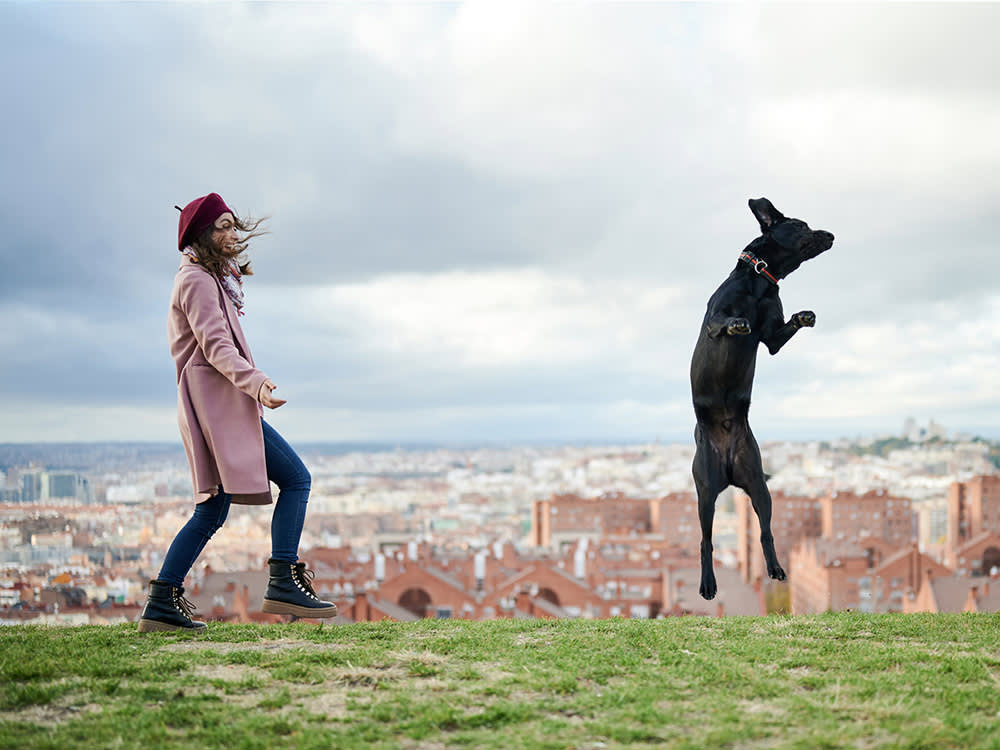Sometimes You Just Gotta Dance — With Your Dog
If your pet’s got moves, canine freestyle is the dog sport you didn’t know you needed.
During his stint as Dwight Schrute on The Office, Rainn Wilson charmed as the lovable tryhard aloof to his own goofiness. Following nine seasons as the character and a seemingly endless stream of memeable lines, he’s now helping other adorable doofuses shine in the form of dog dancing. Yep, it’s a thing — and thanks to Wilson’s We Are the Champions, it’s quickly growing in popularity. The Netflix series documents niche sports — including competitive dog dancing.
“This is like a real-life ‘Best in Show’ where the stakes are as high as you could possibly imagine,” Rainn Wilson said in an interview with Varietyopens in new tab. “When you watch them compete, you’re like, ‘This is ridiculous,’ but then you go, ‘This is beautiful.’”
Get (totally free) deals for food, treats, accessories, tech and way more pet parenting must-haves.
While you might still be figuring out how to get your dog’s attention, these enthusiastic pet parents have their pups grooving to “Tones and I’s Dance Monkey” with elaborate dance routines. Dog dancing, also known as canine freestyle, is choreographed trick training set to music. You’ll recognize some traditional obedience moves, such as heel position, but the overall goal is to get creative and put your dog’s best paw forward. Fans of the sport love the freedom of choosing their own music, designing a routine based on their dog’s strengths, and using verbal encouragement during a performance.
How Did “Dog Dancing” Begin?
Joan Tennille, president and co-founder of the Canine Freestyle Federation (CFF) opens in new tab claims that she defined canine freestyle as a competitive sport rather than just entertainment. In 1993, four dog trainers approached Tennille — at the time, a professional dancer-choreographer — to help them create what would be the first canine freestyle demo. They wanted to showcase their dogs’ advanced obedience training by setting it to music while treating both humans and dogs as equal partners. They showed her a video of a demonstration by a now-defunct Canadian organization.
“There was a woman in high heels and stockings doing ballet with a Golden Retriever,” says Tennille. “There were so many sequins and ruffles, you couldn’t even see the dog, and all the dog did was sit. Another woman had a well-trained Border Collie, but she had heavy sequins and balloons, so again, you couldn’t see the dog. I call that entertainment. That’s not what they wanted.”
Aside from the challenge of giving the dog equal stage presence, Tennille had to think about movement and flow. Four-footed dogs move very differently from two-footed people. Plus, a Border Collie is going to be more agile and light on their feet than a Bloodhound. The demo proved successful, and Canine Freestyle Federationopens in new tab was born two years later. It remains the oldest active canine freestyle organization and is best known for what Tennille calls “performance attitude.”
In 1999, the World Canine Freestyle Organizationopens in new tab (WCFO) made its debut and began offering worldwide competitions the following year. The Musical Dog Sport Associationopens in new tab (MDSA) was then founded in 2002. Its website is a treasure trove for beginners, featuring resources such as a comprehensive (and ever-evolving) list of dog dancing moves and advice on how to find a good canine freestyle trainer. MDSA also recognizes freestyle teams that perform at hospitals, schools, and nursing homes through its Spirit of Sharing program. Since freestyle classes are not available in some areas, MDSA’s Circle of Friends program is a great way for members to meet and train with freestylers in their area.
Canine Freestyle Competitions and Routines
Each organization promotes its own style and hallmarks of competition. As you progress from one level to another, you’re required to perform longer, more challenging routines. Unlike dogs in many other sports, freestyle dogs must focus on their partner for a minimum of 90 seconds and up to three minutes at the most advanced levels. The key is a strong bond and positive training using motivational methods — you really can’t make a dog do freestyle; it’s all about the relationship.
Although most of the top competition dogs are Border Collies and Golden Retrievers, all breeds and mixes are welcome to participate, no matter the organization. Karen Lewis of New Mexico competes in WCFO and MDFA with her six-year-old Staffordshire Bull Terrier, Bryce, who also competes in agility.
“The bond is even more important in freestyle,” says Lewis. “In agility, you pretty much do those obstacles the same way. In freestyle, you’re always doing new moves. The dog has to pay attention to you constantly to get the cues, either verbal or physical. Since you’re supposed to keep up, you’re constantly thinking, What am I doing now? When am I going to say it? It’s amazing what can go on during a one-and-a-half-minute routine.”
Whether you are ready to boost your dog training to the next level, want to build that bond with your pup, or just want to peep at some mesmerizing outfits and top-notch dog training, “dog dancing” might just be what you’re looking for.


